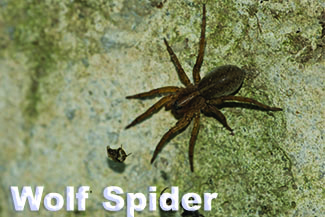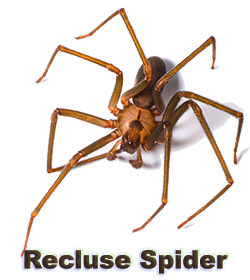Know Your Spiders
how to identify the good Spiders from the bad
There really isn't a good spider vs. bad spider. It just comes down to which one would you rather not run into in a dark alley or even a well-lit hallway.
Most spiders in Arizona are venomous, yet few are dangerous to humans, with the exception of the black widow and brown recluse spiders. Other species (fuzzy ones) may scare the heebie-jeebies out of you, but look worse than they actually are. All spiders are essential to our ecosystem, even if they aren't to our nervous system.
Come On Over!
Tarantula
"Tarantulas are large, hairy spiders that favor desert environments," said Nathan Woolf, general manager, Blue Sky Pest Control. "Though they do bite when provoked, their venom is virtually harmless to humans. The bite can be similar to a bee or wasp sting."

Crab Spider
The crab spider is one of the largest spiders in Arizona. With a leg span of 2 to 2¼ inches, it can scamper rather quickly, extending its legs at right angles from its body, like a crab. Find it in dead saguaros and under rocks. In your home, it can be on the ceiling.
Wolf Spider
Often mistaken for a small tarantula with its larger body and fur, this beneficial spider feeds on other insects, including cockroaches and sometimes enters homes looking for food and water.
House Spider
House spiders are often mistaken for brown recluse spiders because of their similar size and color. Though not particularly aggressive, they will bite when threatened. Their bites heal quickly and pose little danger to humans.
I'll Stay Over Here. You Stay Over There.
Black Widow
Any critter with "widow" in its name can't be a good thing. Black widows are very common throughout Arizona.
Identified by a red or orange hourglass-shaped marking on its body, the female is about 1.5 inches long, while a male is half the size. A black widow's web does not have a distinguishable pattern; it appears haphazard, tangled and crisscrossed. It's also typically constructed close to the ground. Leaves and other debris will often get tangled in the widow's web. The female reproduces up to nine egg sacks in the summer, each containing up to 400 spiderlings. Yup, 400.
Females deliver a poisonous bite. Males have less venom. Bites are characterized by two small red spots surrounded by redness and some slight swelling.
Desert Recluse
 Known as the Desert Recluse, it is typically smaller than an inch and light to medium brown with a "violin" or "fiddle" marking on the top of its head. "Striped wolf spiders and the brown recluse spider with dark markings are often misidentified as recluse spiders," said Woolf.
Known as the Desert Recluse, it is typically smaller than an inch and light to medium brown with a "violin" or "fiddle" marking on the top of its head. "Striped wolf spiders and the brown recluse spider with dark markings are often misidentified as recluse spiders," said Woolf.
Desert recluse webs are irregular, mostly flat, and sticky. They can be difficult to see. Females lay several egg sacs every summer and produce up to 50 eggs per sac.
Their bite can destroy tissue and produce a red, swollen area that may develop into a blister. Bites tend to happen when putting on clothing or shoes that haven't been worn recently. So shake out your bloomers and boots before putting them on.
If you suspect being bitten by a black widow or desert recluse, seek medical attention immediately.
Hide & Seek
The black widow and recluse can be found:
- Under the lip of the stucco, near the foundation
- Corners and undisturbed places in the garage and shed
- Toy bins, cubbies, and sandboxes
- BBQs and patio furniture
- Woodpiles
- Cardboard boxes inside and outside of your home
- Around other clutter and debris
No Vacancy
Keep spiders out of your house and in your garden with these simple measures:
- Destroy spider webs on sight
- Regularly dust ceiling corners and behind frequently open doors.
- Keep crickets and scorpions out of your house - spiders love them.
- Turn off outdoor lights that attract flying insects that spiders eat.
- Seal holes and cracks in your walls, foundation, and roof (but not the weep holes - Watch our How To Seal Cracks and Gaps Around Your Home video)
- Keep your house clean. Spiders hide in dusty areas and around food because other bugs - the ones spiders like to eat - are attracted to it.
- Look for spiders when dragging things out of dark closets or attic.
- Store extra clothes and wrapping paper in plastic containers with tight-fitting lids instead of cardboard boxes.
- Use a leaf blower to clean shelves, corners, and floors in your garage. Spiders don't like areas with a lot of activity.
- Call a Rosie on the House Certified Pest-Control Professional to get rid of them.
So before grabbing a size 15 shoe to squash it or a can of Aqua Net to immobilize it, consider the kind of spider it is and its value to your home's environment.
Home Maintenance To-Do | #GoodSpiderBadSpider
###
Photo Credits:
RELATED CONTENT:
- Blog: Beneficial Bugs We May Want In Our Yard
- Blue Sky Pest Blog: Are there black widow spiders in Arizona?
- DIY FAQ: Is That Snake Dangerous or Not?
- DIY FAQ: How often should I apply a pest-control product?
- DIY FAQ: How To Seal Cracks and Gaps Around Your Home
- View More Pest Articles: Pest Questions and Answers
- Podcast: How to Fight Back Against Bugs That Scare Us The Most
